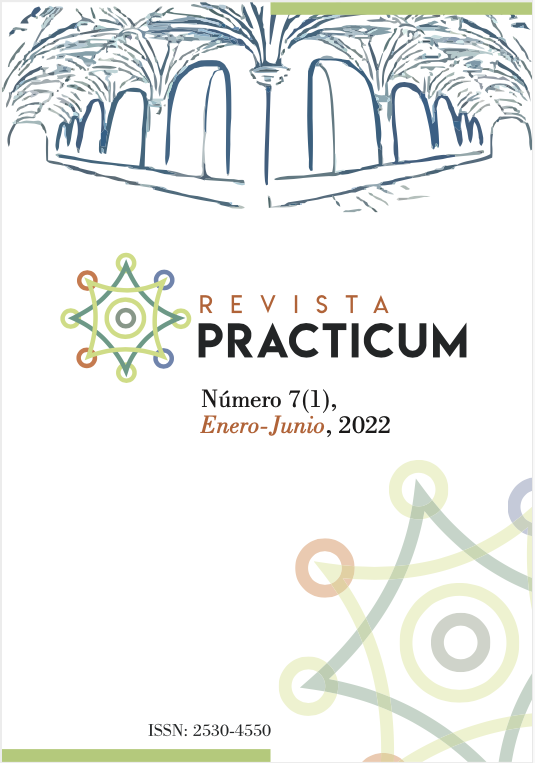Integrar o movimento no último ano do ensino pré-primário: espaços partilhados
DOI:
https://doi.org/10.24310/RevPracticumrep.v7i1.13907Palavras-chave:
Integração de movimentos, espaços partilhados, metodologias activas, actuação física, Educação da Primeira InfânciaResumo
O objectivo desta investigação é analisar espaços partilhados, uma prática inovadora na Educação Infantil relacionada com a integração do movimento nos conteúdos académicos, bem como a sua influência na aprendizagem e na quantidade de actividade física realizada pelos estudantes. O estudo incluiu 25 estudantes (15 rapazes e 10 raparigas) de 5 anos de idade de um centro educativo da província de Málaga. A investigação adopta uma perspectiva analítico-descritiva, utilizando o estudo de caso juntamente com outros métodos de recolha e análise de informação. Os resultados mostram a necessidade e a importância de implementar metodologias activas, tais como espaços partilhados que aumentam a quantidade de actividade física dos estudantes, bem como os benefícios que traz para o desenvolvimento físico, cognitivo, social e para os processos de ensino-aprendizagem, que se tornam mais activos e significativos.
Downloads
Métricas
##plugins.generic.pfl.publicationFactsTitle##
##plugins.generic.pfl.reviewerProfiles## Indisp.
##plugins.generic.pfl.authorStatements##
##plugins.generic.pfl.indexedIn##
-
##plugins.generic.pfl.indexedList##
- ##plugins.generic.pfl.academicSociety##
- Indisp.
- ##plugins.generic.pfl.publisher##
- Universidad de Málaga
Referências
Baker, E.A., Elliott, M., Barnidge, E., Estlund, A., Brownson, R.C., Milne, A., Kershaw, F. y Hashimoto, D. (2017). Implementing and evaluating environmental and policy interventions for promoting physical activity in rural schools. Journal of School Health, 87(7), 538–545. https://doi.org/10.1111/josh.12522
Bartholomew, J.B., Jowers, E.M., Errisuriz, V.L., Vaughn, S. y Roberts, G. (2017). A cluster randomized control trial to assess the impact of active learning on child activity, attention control, and academic outcomes: The Texas I-CAN trial. Contemporary Clinical Trials, 61, 81-86. https://doi.org/10.1016/j.cct.2017.07.023
Bassett, D.R., Fitzhugh, E.C., Heath, G.W., Erwin, P.C., Frederick, G.M., Wolff, D.L., Welch, W.A. y Stout, A.B. (2013). Estimated energy expenditures for school-based policies and active living. American Journal of Preventive Medicine, 44(2), 108–113. http://doi.org/10.1016/j.amepre.2012.10.017
Bautista, N.P. (2011). Proceso de la investigación cualitativa. Epistemología, metodología y aplicaciones. El Manual Moderno.
Belton, S., Brady, P., Meegan, S. y Woods, C. (2010). Pedometer step count and BMI of Irish primary school children aged 6-9 years. Preventive Medicine, 50(4), 189-92. http://doi.org/10.1016/j.ypmed.2010.01.009
Blakemore, C.L. (2003). Movement is essential to learning. Journal of Physical Education, Recreation & Dance, 74(9), 22-25. https://doi.org/10.1080/07303084.2003.10608514
Center for Disease Control and Prevention of America. (2010). The association between school-based physical activity, including physical education, and academic performance. US Department of Health and Human Services. https://cutt.ly/RT7vqSF
Comisión Europea (2018). Special Eurobarometer 472. Sport and Physical Activity. http://doi.org/10.2766/483047
Dobbins, M., Husson, H., DeCorby, K. y LaRocca, R.L. (2013). School-based physical activity programs for promoting physical activity and fitness in children and adolescents aged 6 to 18. The Cochrane Database of Systematic Reviews, 21(1), CD007651. http://doi.org/10.1002/14651858.CD007651
Donnelly, J., Greene, J., Gibson, C., Smith, B., Washburn, R., Sullivan, D., Du Bose, K., Mayo, M.S., Schmelzle, K.H., Ryan, J.J. Jacobsen, D.J. y Williams, S.L. (2009). Physical activity across the curriculum (PAAC): a randomized controlled trial to promote physical activity and diminish overweight and obesity in elementary school children. Preventive Medicine, 49(4), 336-341. http://doi.org/10.1016/j.ypmed.2009.07.022
Drummy, C., Murtagh, E.M., McKee, D.P., Breslin, G., Davison, G.W. y Murphy, M.H. (2016). The effect of a classroom activity break on physical activity levels and adiposity in primary school children. Journal of Pediatrics and Child Health, 52(7), 745–749. http://doi.org/10.1111/jpc.13182
Erwin, H., Fedewa, A., Beighle, A. y Ahn, S. (2012). A quantitative review of physical activity, health, and learning outcomes associated with classroom-based physical activity interventions. Journal of Applied School Psychology, 28(1), 14-36. http://doi.org/10.1080/15377903.2012.643755
Escudero, J.M. (2014). Avances y retos en la promoción de la innovación en los centros educativos. Educar, 101-138. http://dx.doi.org/10.5565/rev/educar.693
Fairclough, S.J., Beighle, A., Erwin, H. y Ridgers, N.D. (2012). School day segmented physical activity patterns of high and low active children. BMC Public Health, 12(1), 406. https://doi.org/10.1186/1471-2458-12-406
Fernández, M. y Alcaraz, N. (coords.) (2016). Innovación educativa. Más allá de la ficción. Pirámide.
Goh, T.L., Hannon, J.C., Webster, C.A. y Podlog, L. (2017). Classroom teachers’ experiences implementing a movement integration program: Barriers, facilitators, and continuance. Teaching and Teacher Education, 66, 88-95. https://doi.org/10.1016/j.tate.2017.04.003
Head Start Resource Center (2010). The Head Start Child Development and Early Learning Framework: Promoting positive outcomes in early childhood programs serving children 3-5 years old. U.S. Office of Head Start. https://files.eric.ed.gov/fulltext/ED547179.pdf
Hebbeler, K., Barton, L.R. y Mallik, S. (2008). Assessment and accountability for programs serving young children. Exceptionality, 16(1), 48–63. https://doi.org/10.1080/09362830701796792
Holt, E., Bartee, T. y Heelan, K. (2013). Evaluation of a policy to integrate physical activity into the school day. Journal of Physical Activity & Health, 10(4), 480-487. https://doi.org/10.1123/jpah.10.4.480
Huberty, J.L., Siahpush, M., Beighle, A., Fuhrmeister, E., Silva, P. y Welk, G. (2011). Ready for recess: a pilot study to increase physical activity in elementary school children. Journal of School Health, 81(5), 251-257. https://doi.org/10.1111/j.1746-1561.2011.00591.x
Kilbourne, J.R. (2013). Moving physical education beyond the gymnasium: Creating activity permissible classrooms. http://works.bepress.com/john_kilbourne/6/
Kuczala, M. y Lengel, T. (2018). Ready, set, go!: The kinesthetic classroom 2.0. Corwin Press.
Malaguzzi, L. y Hoyuelos, A. (2014). La educación infantil en Reggio Emilia. Octaedro.
Martin, R. y Murtagh, E.M. (2017). Effect of active lessons on physical activity, academic, and health outcomes: A systematic review. Research Quarterly for Exercise and Sport, 88(2), 149–168. https://doi.org/10.1080/02701367.2017.1294244
Mullender-Wijnsma, M.J., Hartman, E., de Greeff, J.W., Bosker, R.J., Doolaard, S. y Visscher, C. (2015). Improving academic performance of school-age children by physical activity in the classroom: 1_year program evaluation. Journal of School Health, 85(6), 365-371. https://doi.org/10.1111/josh.12259
Piek, J., Dawson, L., Smith, L.M. y Gasson, N. (2008). The role of early fine and gross motor development on later motor and cognitive ability. Human Movement Science, 27(5), 668–681. https://doi.org/10.1016/j.humov.2007.11.002
Ramírez, W., Vinaccia, S. y Suárez, G.R. (2004). El impacto de la actividad física y el deporte sobre la salud, la cognición, la socialización y el rendimiento académico: una revisión teórica. Revista de Estudios Sociales, 18, 67-75. https://cutt.ly/1T7WRJj
Riera, M.A., Ferrer, M. y Ribas, C. (2014). La organización del espacio por ambientes de aprendizaje en la Educación Infantil: significados, antecedentes y reflexiones. Revista Latinoamericana de Educación Infantil, 3(2), 19-39. https://cutt.ly/UT7Tnvd
Roebers, C.M., Röthlisberger, M., Neuenschwander, R., Cimeli, P., Michel, E. y Jäger, K. (2014). The relation between cognitive and motor performance and their relevance for children’s transition to school: A latent variable approach. Human Movement Science, 33, 284–297. https://doi.org/10.1016/j.humov.2013.08.011
Ruiz, J.I. (2012). Metodología de la investigación cualitativa. Universidad de Deusto.
Schiller, P. (2018). La capacidad cerebral en la primera infancia. Narcea Ediciones.
Simons, H. (2011). El estudio de caso: teoría y práctica. Morata.
Tomporowski, P., Davis, C., Miller, P. y Naglieri, J. (2008). Exercise and children's intelligence, cognition, and academic achievement. Educational Psychology Review, 20(2), 111 - 131. https://doi.org/10.1007/s10648-007-9057-0
Trudeau, F. y Shephard, R. (2008). Physical education, school physical activity, school sports and academic performance. International Journal of Behavioral Nutrition & Physical Activity, 5, 10. https://doi.org/10.1186/1479-5868-5-10
Waters, E., de Silva-Sanigorski, A., Burford, B.J., Brown, T., Campbell, K.J., Gao, Y., Armstrong, R., Prosser, L. y Summerbell, C.D. (2011). Interventions for preventing obesity in children. Cochrane Database of Systematic Reviews, 12, CD001871. https://doi.org/10.1002/14651858.CD001871
Watson, A., Timperio, A., Brown, H., Best, K. y Hesketh, K.D. (2017). Effect of classroom-based physical activity interventions on academic and physical activity outcomes: A systematic review and meta-analysis. International Journal of Behavioral Nutrition and Physical Activity, 14(1), 114. https://doi.org/10.1186/s12966-017-0569-9
World Health Organization (2019). Guidelines on physical activity, sedentary behaviour and sleep for children under 5 years of age. https://apps.who.int/iris/handle/10665/311664
Downloads
Publicado
Como Citar
Edição
Seção
Licença
A aceitação da obra implica a cedência do autor à Revista Prácticum, em exclusividade, dos direitos de reprodução, distribuição e venda da sua obra em todo o mundo, tanto em formato digital como em papel, CD- ROM, entre outros.
Os autores cederão igualmente à Revista Prácticum os direitos de difusão e comunicação pública na internet e nas redes informáticas, bases de dados, e qualquer outro portal ou dispositivo eletrónico para consultas online dos seus conteúdos e extratos, de acordo com as condições do portal, dos repositórios ou das bases de dados em que se encontre a obra.
A Revista Prácticum concede aos autores a publicação e difusão dos seus artigos e obras nas suas páginas pessoais na internet, equipas de investigação, repositórios institucionais e bases de dados científicas, sempre de acordo com o estipulado na Licença Creative commons 3.0










8.png)








